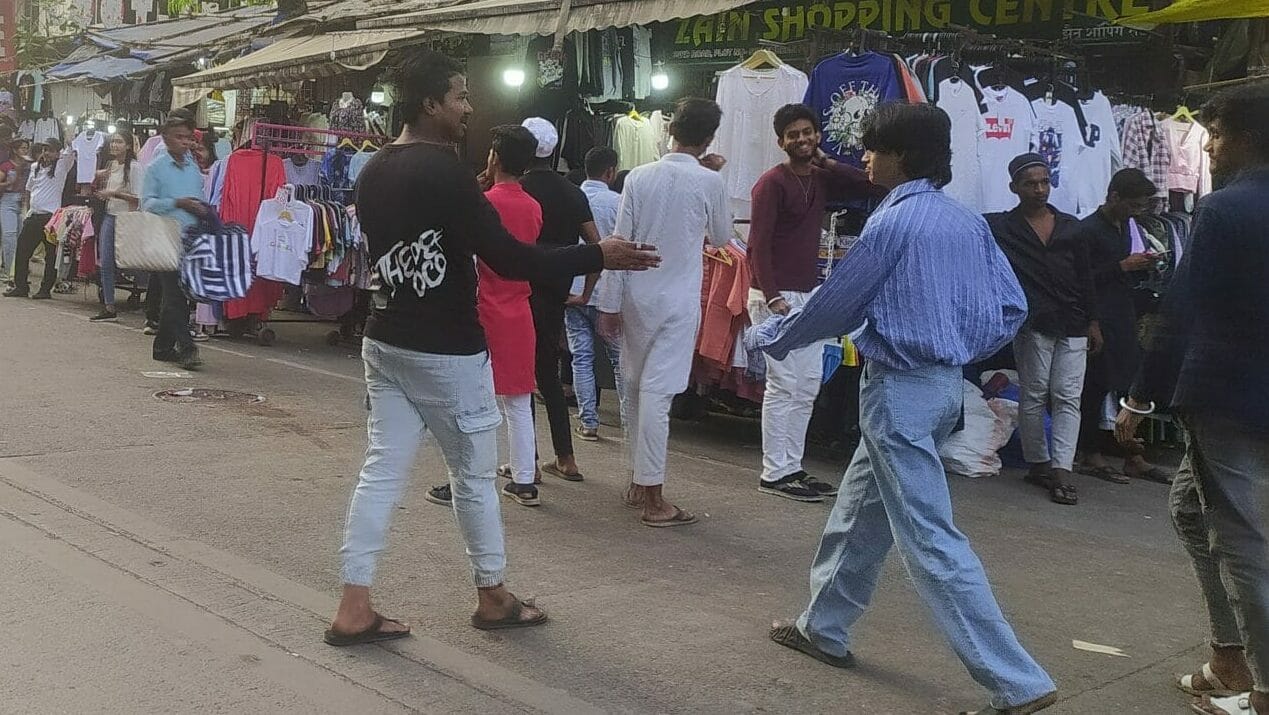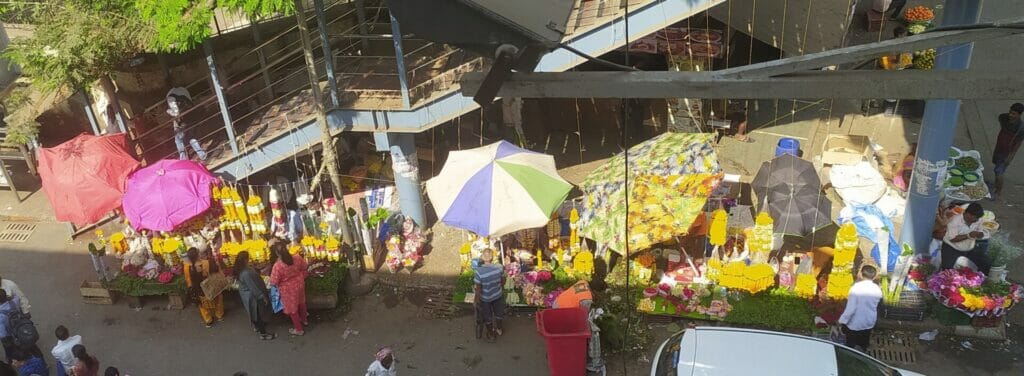Be it Fashion Street, Linking Road, Colaba Causeway or the buzzing Khau Gallis offering a variety of delicacies in various localities, Mumbai is known by its lively street markets run by hawkers. They have a distinct character that attracts shoppers from Mumbai and outside, and have even become a tourist attraction.
The book shops on pavements around Flora Fountain, which were an enduring source of knowledge, now invoke nostalgic memories for generations of book lovers. Similarly, Chor Bazaar is a source of art installations and furniture for art connoisseurs and collectors. Several useful services from typists to affidavit papers to various legal services are available outside court premises.
Streets offer good variety, unmatched bargain deals and save time for hurried shoppers. It is such an inherent part of the city’ culture that viewing the streets only for mobility would be ignoring this important aspect of Mumbai’s street life.
Are hawkers illegal and to be evicted?
More often than not, hawkers are at the receiving end of civic eviction drives – sometimes when the city needs a spruced up look for a visit from a VIP or an international delegation, other times as routine action to make roads hawker-free.
However, hawking on streets has been legal since 2014 when the union government passed The Street Vendor’s (Protection of Livelihood and Regulation of Street Vending) Act, 2014. Brought by the union ministry of housing and poverty alleviation, the Act perceives hawking as a source of livelihood that needed to be accorded dignity.

Subsequently, the state government passed the Maharashtra Street Vendors (Protection of Livelihood and Regulation of Street Vending) (Maharashtra) Rules, 2016 that laid down guidelines about the Town Vending Committees (TVC), which would determine hawking zones, provide hawking licenses and earmark hawking pitches or spots for vending.
Prior to 2014, broader rules about hawking were drafted by the BMC in 1983 and ratified thereafter by the Supreme Court in 2013 and Bombay High Court in 2017 including a ban on cooking on streets. The rules prohibited hawking on roads narrower than 8 m width and mandated that shops sell related items, such as flowers and incense sticks (agarbattis) in front of temples or coconut water in front of hospitals.
According to the same rules, hawking is not allowed in exclusively residential areas and within 100 metres of educational institutions and hospitals or within 150 meters of markets and railway stations. Hawkers are allowed to sell between 7 am to 10 pm and cannot make any noise or play any instrument or music to attract customers.
Is the policy paralysis deliberate?
Despite such clear orders, there continues to be a huge gap between the hawkers’ policy in documents and the reality on the ground.
Currently, as per the Brihanmumbai Municipal Corporation (BMC) records, only 15,361 hold licenses to vend in Mumbai from the 99,435 applications in 2014. Today Mumbai has over three lakh hawkers, estimates Dayashankar Singh, president of Azad Hawkers Union, who is also part of the central Town Vending Committee (TVC).
Though the Livelihoods Act had recommended Town Vending Committee (TVC)’s to allocate spaces for hawking, and even issue vending licenses, no such licenses were ever issued by them. The existing TVC is provisional and no elections have been conducted so far – a legal prerequisite for their functioning.
In fact, the TVC did not even meet regularly post-Covid. “The BMC wants to avoid allocating legal hawking pitches and granting official vending licenses and hence deliberately prefers things in a state of limbo. In fact, though all the seven zonal TVC’s had already surveyed and finalised their pitches allocation plans by 2019, it never got implemented. The entire procedure was stayed by the BMC after corporators insisted on being part of the process,” say Singh.

Dichotomy in government approach
Meanwhile, the dichotomy and confusion in dealing with hawkers continues in policies. Recently, hawkers were officially invited by the BMC to enlist for the Prime Minister’s SVANidhi schemes to receive collateral-free working capital loans. While the hawkers were asked to apply for the loans, the same license department simultaneously continued to conduct demolition drives on the same hawkers.
“About 1.28 lakh hawkers enrolled for the SVANidhi scheme from Mumbai after we were promised protection from evictions and even provisional vending certificates as sops for enrolling. We told the government that we don’t need loans; instead, give us vending rights and we would be happy to pay for that. But, local BMC authorities refuse to recognise our rights, which are legal and documented on paper. But they mean nothing on the ground because of the sustained eviction drives against us. How are we to repay the loans, if they do not allow us to conduct our own business?” asks Dayashankar Singh.
In its policy statement available on its website, the BMC states that currently it only undertakes “encroachment removal action under section 314 (C) of Mumbai Municipal Corporation Act 1888 against unauthorized hawkers squatting on more than 1mt x 1 mt area, obstructing pedestrian way and blocking the entrance of shops and residences on municipal footpaths / roads except licensed hawkers. As per orders given by Hon’ble High Court in WP 652 of 2017 dt. 01/11/2017, 150 meters from railway stations are kept hawkers free.” (sic)
Read more: Footpaths in Mumbai: walking may be injurious to your health
Hawkers and city planning
In a report titled, “Strengthening Urban India’s informal economy: The case of Street vending”, published by the Observer Research Foundation, former IAS officer Ramnath Jha laments that despite street vending being one of the oldest forms of retail in the country, the urban laws of independent India still neglects the activity and its practitioners. He observes, “While the Street Vending Act asks planning laws to take cognizance of the requirements of street vending and align state planning laws to vending needs, little has been done in practice to achieve this.”
Despite being an integral part of the city, there is no mention of hawkers in the city’s long-term planning document, Development Control and Promotion Regulation Plan (DCPR) – 2034. Some have found spaces in the few hawkers’ plaza, but it is more because of initiatives by politicians at local level and not a policy decision.
Urban designer and architect Samarth Das points that hawkers exist because there is a genuine patronage for their goods and services from citizens and hence should be incorporated into the city’s development plans. He gave the example of food stalls at Juhu beach that were successfully taken off the beach and relocated at an adjoining area by way of a planned food court. He says: “There is plenty of scope for urban planners and policy makers to make space for hawkers in un-utilised and under-utilised neighbourhood spaces, if there is a will to do it. They should be integrated into the city’s development plans as they bring value to the daily lives of people living in the city,” says Das.
In fact, the 2012 report of the Indian Roads Congress (IRC), that offers guidelines on the nature of streets across the country, had recommended that hawkers should be allowed on footpaths as they are a part of the city’s heritage and culture. It had also recommended that hawkers be incorporated within the furniture zone of the footpath, which is one metre wide.
Read more: What are the demands of Mumbai’s street vendors?
However, this accommodative spirit towards hawkers failed to reflect in BMC’s Pedestrians First policy, 2016. A BMC official explained: “We are already struggling with lack of space for pedestrians due to excess hawkers. Where and how are we to adjust hawkers in this scenario?”
In Mumbai’s townships and gated communities, hawkers have never been incorporated in the planning stage but eventually end up making inroads. While most citizens agree that street shopping is useful, they feel it needs to be better planned and regulated.
Do citizens want hawkers?
Banker Prashant Jain, who prefers to buy vegetables on his way back from work, after alighting from a metro, feels that hawkers are a necessity for any citizen and spaces should be facilitated for them. “Most working commuters tend to shop for vegetables and other household requirements outside stations, either railway or metro. All transport planners must consider holistic needs of the commuters and incorporate hawkers, as it happens in Singapore. There, one can pick up stuff within the station premises from various hawkers and it is quite convenient for commuters. One doesn’t have to search for stuff after stepping out from the stations.”
His wife, Nidhi Jain, an IT professional, feels that since hawkers are a necessity for all, considering “the unmatched variety offered by them,” they should be allowed to hawk at designated open spaces in localities for specific hours as done in cities like Indore. “There hawkers are allocated specific hours in a day on playgrounds, which are used by schools during school hours and by other children in the evening. This ensures multi-use of open spaces and also ensures hawkers remain concentrated in a specific zone and don’t spread,” says Nidhi.

The way forward
While hawkers are convenient and useful, there is no doubt that an excessive number of hawkers taking over walking spaces becomes a nuisance and needs to be regulated.
Ramnath suggests in his report that street vending, if designed properly, has the potential to add to the efficiency of a city. He also feels that parking spaces that are not utilised on holidays can be opened up for vending for concepts like Sunday or holiday markets. He also suggests vending spaces could be created in housing schemes and markets.
With national and state elections expected in 2024, it remains to be seen how all the existing regulations actually work out on the streets of Mumbai.
BMC should allocate vending spaces in residential areas specially in low income areas viz. Dharavi, Govandi, etc. and also make it sure that the allocated space should used for a limited time in a day/week and also restrict the space getting permanently encroached by vendors.